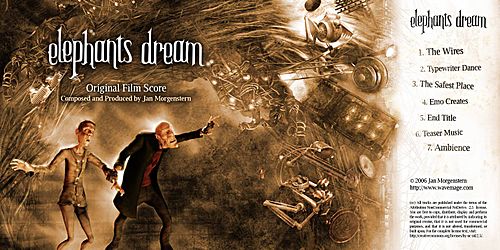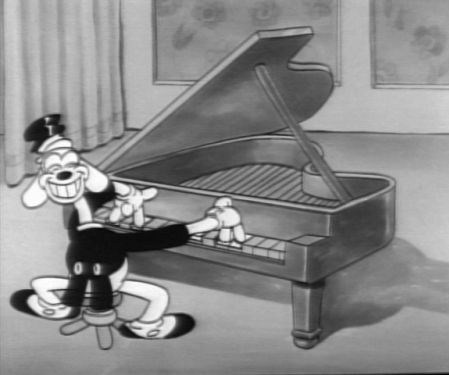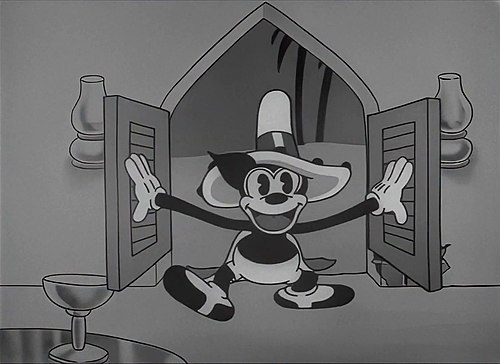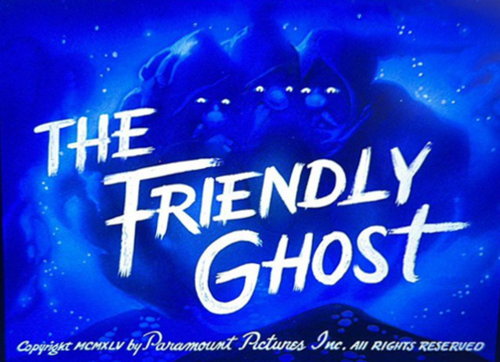Advertisement

Image source: Wikimedia Foundation (wikimedia.org)
Download Movie [Video Format: MP4]
Movie Source: Internet Archive (archive.org)
Advertisement
Advertisement
Other Versions of this Movie
Elephants Dream
Elephants Dream is the story of two strange characters exploring a capricious and seemingly infinite machine. The elder, Proog, acts as a tour-guide and protector, happily showing off the sights and dangers of the machine to his initially curious but increasingly skeptical protege Emo. As their journey unfolds we discover signs that the machine is not all Proog thinks it is, and his guiding takes on a more desperate aspect.
Elephants Dream (code-named Orange) is a Computer-generated imagery short film that was produced almost completely using the free software 3D suite Blender software (except for the modular sound studio Reaktor and the cluster that rendered the final production, which ran Mac OS X). It premiered on 24 March 2006, after about 8 months of work. Beginning in September 2005, it was developed under the name Orange by a team of seven artists and animators from around the world. It was later renamed Machina and then to Elephants Dream after the way in which Netherlands children's stories abruptly end.<></>
Overview
File:Elephants Dream (high quality).ogvThe film was first announced in May 2005 by Ton Roosendaal, the chairman of the Blender Foundation and the lead developer of the foundation's program, Blender (software). A 3D modelling, animating, and rendering application, Blender was the primary piece of software used in the creation of the film. The project was joint funded by the Blender Foundation and the Netherlands Media Art Institute. The Foundation raised much of their funds by selling pre-orders of the DVD. Everyone who preordered before September 1 has his or her name listed in the film's credits. The bulk of processing for rendering the film was donated by the BSU Xseed, a 2.1 TFLOPS Apple Xserve G5-based supercomputing cluster at Bowie State University. It reportedly took 125 days to render, consuming up to 2.8GB of memory for each frame.<></> The completed film is 10 minutes 54 seconds long, including 1 minute and 28 seconds of credits.
The film's purpose was primarily to field test, develop and showcase the capabilities of Open-source software, demonstrating what can be done with such tools in the field of organizing and producing quality content for films.
During the film's development, several new features such as an integrated node-based compositor, hair and fur rendering, rewritten animation system and render pipeline, and many workflow tweaks and upgrades were added into Blender especially for the project.<></>
The film's content was released under the Creative Commons Attribution license, so that viewers may learn from it and use it however they please (provided attribution is given).<></> The DVD set includes NTSC and PAL versions of the film on separate discs, a high-definition video version as a computer file, and all the production files.
The film was released for download directly and via BitTorrent (protocol) on the Official Orange Project website on May 18, 2006, along with all production files.
Plot and explanation
File:Elephants Dream f11621.png in one of the ending frames of the film.}}}The movie was made mostly as an experiment, rather than to tell a certain story, and theore has a strong arbitrary and surreal atmosphere. It features two men, Proog, who is older and more experienced, and Emo, who is young and nervous, living in a miraculous construction erred to only as "The Machine". Proog tries to introduce Emo to The Machine's nature but Emo is reluctant and argues about The Machine's purpose. The creators originally intended for the movie to show the abstraction of a computer.
Bassam Kurdali, Director of Elephants Dream, explained the plot of the movie by saying:
<blockquote>
"The story is very simple—I'm not sure you can call it a complete story even—It is about how people create ideas/stories/fictions/social realities and communicate them or impose them on others. Thus Proog has created (in his head) the concept of a special place/machine, that he tries to "show" to Emo. When Emo doesn't accept his story, Proog becomes desperate and hits him. It's a parable of human relationships really—You can substitute many ideas (money, religion, social institutions, property) instead of Proog's machine—the story doesn't say that creating ideas is bad, just hints that it is better to share ideas than force them on others. There are lots of little clues/hints about this in the movie—many little things have a meaning—but we're not very "tight" with it, because we are hoping people will have their own ideas about the story, and make a new version of the movie. In this way (and others) we tie the story of the movie with the "open movie" idea."<></>
</blockquote>
The original title was to be Machina but was dropped due to pronunciation issues.
Stereoscopic 3D version
In 2010 Elephants Dream was entirely re-rendered in Stereoscopy by Wolfgang Draxinger. The project was announced to the public in mid September on BlenderNation<></> and premiered on the 2010 Blender Conference.<></>Unlike the original version, which was in Full-HD resolution (1920×1080), the stereoscopic version was rendered in Digital Cinema Package (DCP) Digital Cinema Initiatives#Image and audio capability overview resolution (1998×1080), a slightly wider aspect format, which required adjustment of the camera lens parameter in every shot. Many scenes in the original production files used flat 2D matte paintings, which were integrated into the rendered images during the compositing phase. For the 3D production each matte painting had to be manipulated or entirely recreated into versions for each eye.
Wolfgang Draxinger implemented a number of stereoscopic features in Blender (software) to aid in the stereoscopic production process. These never made into Blender trunk though.
=Award=
Elephants Dream 3D received the award of "Best Short Film" at the first European 3D Film Festival.<></>Short film video
File:Elephants Dream.oggCast
- Tygo Gernandt - Proog
- Cas Jansen - Emo
Crew
- Ton Roosendaal - Film producer
- Bassam Kurdali - Animation director
- Andy Goralczyk - Art director
- Matt Ebb - Artist
- Bastian Salmela - Artist
- Lee Salvemini - Artist
- Toni Alatalo - Technical director
- Jan Morgenstern - Composer
Software and tools used
Blender was the main program used to create the 3D animation of the film. The other programs were used for pre and post-production, file management, collaboration, and scripting. Ubuntu with KDE and GNOME desktop environments was used on the workstations.
<!--http://media.xiph.org/ED/ED-1080-png/14547.png is the frame showing the software used-->
{|
|-
|valign=top|
- Blender (software)
- DrQueue
- Inkscape
- Python (programming language)
- Seashore (software)
- Twisted (software)
- Verse protocol
- CinePaint
- GIMP
- OpenEXR
- Reaktor (Proprietary)
- Subversion (software)
- Ubuntu (operating system) (GNOME and KDE desktop)
Notes
Category:2006 films
Category:Blender Foundation
Category:Computer-animated short films
Category:Dutch films
Category:Open content short films
Category:Creative Commons-licensed films
Category:2006 computer-animated films
Category:Dutch animated films
Category:Dutch short films
Project Orange




